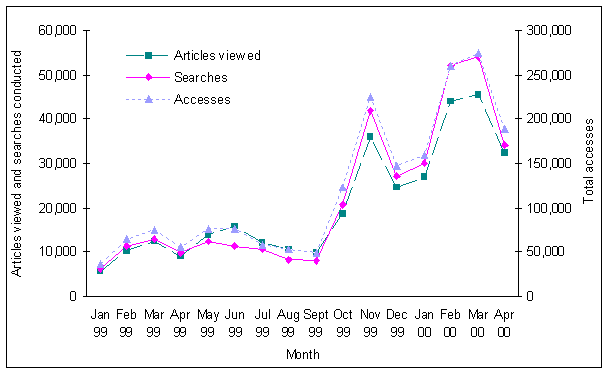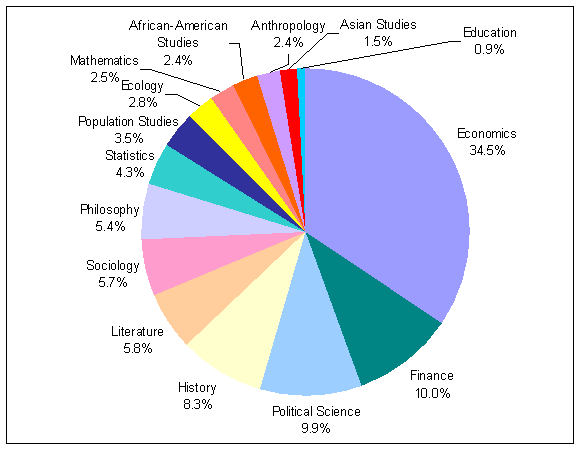JSTOR Usage
JSTOR (Journal STORage) is a unique digital archive of over 100 core scholarly journals, starting with the very first issues. The collection covers material from the 1800s up to a ‘moving wall’ of between 1 and 8 years before current publication. It covers 15 subjects at present, mainly in the Humanities and Social Sciences. JSTOR is made available to academic institutions around the world on a site-licence basis. Users at participating institutions can search, browse, print and save any article from the collection.
JSTOR started as a pilot project in the United States, funded by the Andrew W. Mellon Foundation. The aim was to provide a solution to the increasing costs to libraries of storing back runs of journals. The project proved so successful that a full service was launched in January 1997 in the US. JSTOR is now an independent, non-profit making organisation.
Usage
Following the success of the full service in the US, March 1998 saw the launch of the UK JSTOR Mirror Service, maintained by MIMAS (Manchester Information and Associated Datasets) on behalf of the Joint Information Systems Committee (JISC). Since the launch, 41 UK and 7 Eire higher education institutions have subscribed to the service. [1] The UK service started with 48 journal titles online, covering 138,000 full-length articles (382,000 including letters, reviews etc.) from 14,000 issues. As of January 2000, there are 117 titles available online [2], containing 307,000 full-length articles from just under 30,000 journal issues. This amounts to over 4.7 million pages of journal literature.
Usage of JSTOR has increased dramatically. During April 1998, the first full month of operation, there were 11 subscribing institutions. These institutions conducted 821 searches and printed 236 articles; a total of 2,376 pages from 849 articles were viewed online. By April 2000 there were 50 subscribing institutions conducting over 34,000 searches, printing nearly 15,000 articles and viewing 93,000 pages from over 32,000 articles. Figure 1 below illustrates the rise in use since January 1999.

Figure 1: JSTOR usage, Jan 1999 - Apr 2000
Looking at usage by subject, Economics journals receive by far the most use. In the first four months of 2000, there were 295,000 accesses of Economics journals compared to 300,000 in the whole of 1999. So far this year, 34.4% of all access have been to Economics titles. Finance (10.1% of accesses), History (8.4%) and Political Science (10.0%) journals are also very well used. This follows a similar pattern of use in 1999. Figure 2 shows the percentage of accesses to each subject cluster in 2000.

Figure 2: Accesses to each subject cluster, Jan - Mar 2000
Since they subscribed in 1998, Oxford University and the London School of Economics have consistently been the heaviest users of JSTOR. On average, institutions made 27,000 accesses each to JSTOR in the whole of 1999, compared to 24,000 so far in 2000. For subscription purposes, institutions are placed into one of four bandings: very small, small, medium and large. On average, large institutions, of which there are 33 subscribers, made 25,000 accesses to JSTOR in the first four months of 2000, compared to 22,000 from medium sites (10 subscribers), 11,000 from small sites (3 subscribers) and 8,000 from very small sites (3 subscribers).
In 1999, 76,288 articles were printed from the database. In the first four months of 2000, there have been 77,132 print outs. JSTOR offers three options for printing articles:
- JPRINT, JSTOR’s own helper application
- Adobe Acrobat Reader
- Postscript printing
Printing with Acrobat Reader is the most popular option. In 1999, just over 53,000 articles were printed using Acrobat Reader - 70% of all articles printed. This year the figures are slightly higher 55,000 articles (71%). Printing using JPRINT accounts for around 25% and postscript printing just over 4%.
MIMAS is very excited about this trend in usage and is positioning the service to be upgraded prior to the new semester. It is vital that the quality of service to the subscribing institutions is maintained at its current high level.
References
- A list of all these participants can be found at: http://www.mimas.ac.uk/jstor/jaccess.html
- A complete list of titles, including years covered by the database, is available at: http://www.jstor.ac.uk/about/content.html
Author Details
| Alison Murphy Ejournal Support (JSTOR/NESLI) MIMAS University of Manchester Email: alison.murphy@man.ac.uk |
